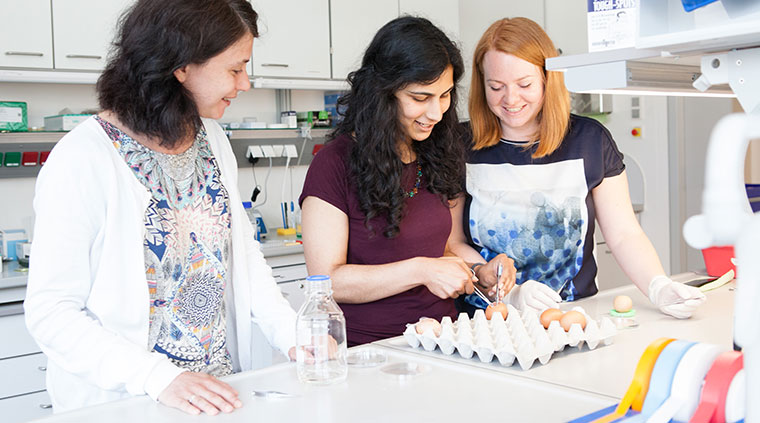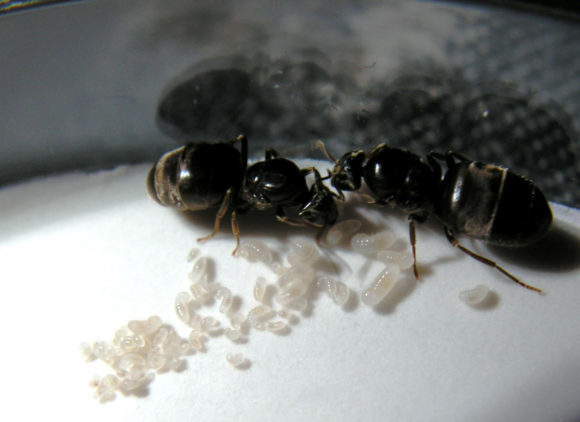
Biology at ISTA encompasses a wide variety of research areas, from structural and molecular biology to cell and development biology to systems and evolutionary biology.
Biology is the largest track in the PhD program, and students benefit from a vibrant research community with collaborations within and across sub-fields. State-of-the-art facilities and interactions with chemistry, mathematics, computer science and physics allow scientists to address complex problems with interdisciplinary scope.
COMPLETE BIOLOGY RESEARCH GROUP DETAILS ON ISTA’S MAIN SITE:
- Evolutionary Genetics
NICK BARTON - Plant Developmental Biology
EVA BENKOVA - RNA-Based Gene Regulation
CARRIE BERNECKY - Bacterial Immune systems
JACK BRAVO - Social Immunity
SYLVIA CREMER - High-Resolution Optical Imaging for Biology
JOHANN DANZL - Genes, Circuits, and Behavior
MARIO DE BONO - Reproductive Genetics and Epigenetics
Xiaoqi Feng - Developmental and Cell Biology of Plants
JIří FRIML - Systems and Synthetic Biology of Genetic Networks
CăLIN GUET - Physical Principles in Biological Systems
Edouard HANNEZO - Morphogenesis in Development
CARL-PHILIPP HEISENBERG - Protein Homeostasis and Aging
MARTIN HETZER - Genetic Dissection of Cerebral Cortex Development
SIMON HIPPENMEYER - Tissue Growth and Developmental Pattern Formation
ANNA KICHEVA
- Self-Organization of Protein Systems
MARTIN LOOSE - Genome Regulation and Biological Timekeeping
ALICIA MICHAEL - Biomolecular Design
FLORIAN PRAETORIUS - Medical Genomics
MATTHEW ROBINSON - Computational Soft and Living Matter
ANDELA SARIC - Structural Biology of Membrane Protein Complexes
LEONID SAZANOV - Biomolecular Mechanisms from Integrated NMR Spectroscopy
Paul SCHANDA - Structural Biology of Cell Migration and Viral Infection
Florian SCHUR - Microglia-Neuron Interaction
SANDRA SIEGERT - Cellular Morphodynamics
MICHAEL SIXT - Evolution, Development and Function of Motor Circuits
Lora SWEENEY - Information Processing in Biological Systems
GASPER TKACIK - Sex-Chromosome Biology and Evolution
BEATRIZ VICOSO - Epigenetics and Chromatin
DANIEL ZILBERMAN
Here is a video presenting the Biology study track. In case you cannot access YouTube, this video is also available here.
Barton Group
Video
Here is a video presenting the Barton group, which studies diverse topics in evolutionary genetics. The video has been shot by recent ISTA PhD graduate Eniko Edelsbrunner.
Featured Projects:
Arabidopsis Root Growth
Friml Group
To track the growth of plant roots, the Friml group— in cooperation with the Bioimaging Scientific Service Unit—developed a confocal microscope setup for vertical sample mounting. In addition, they developed a custom software called TipTracker, which can automatically track moving objects and record time-lapse series.
Using this setup, it is possible to study the growth of Arabidopsis roots under different gravity (through rotation of the sample) and light conditions. In addition, TipTracker can even be used to study other non-plant samples, such as zebrafish embryos—an animal model used by one of our PhD students, Vanessa Barone (Heisenberg group), to study embryonic development.
Watch a time-lapse video showing root growth over time, produced using TipTracker.
The work was produced by Daniel von Wangenheim, Robert Hauschild, Matyas Fendrych, Vanessa Barone, and Jiri Friml. Read the original paper here: https://doi.org/10.1101/116285
Ant queens bury dead to prevent disease
Christopher Pull
PhD student, Cremer Group
Christopher Pull published a study in the open access journal BMC Evolutionary Biology (DOI: 10.1186/s12862-017-1062-4), which suggests that ant queens may bury other queens to prevent pathogen transmission.

The full press release can be found here on the ISTA main website.
